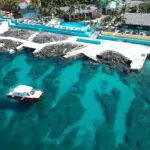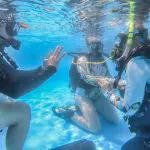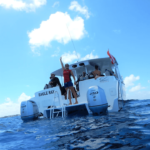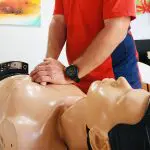When you think of scuba diving in the stunning, crystal-clear waters of Grand Cayman, you may picture vibrant coral reefs, swaying sea fans, and a captivating kaleidoscope of marine life. But if you’re not properly weighted for neutral buoyancy, that serene, graceful underwater experience could feel more like a tug-of-war between floating and sinking!
At Sunset House, we provide custom Grand Cayman dive packages and standalone diving trips with Sunset Divers. No matter the nature of your dive with us, we want your adventure to be as smooth and enjoyable as possible. With that in mind, we’ve created this guide to help you master one of the most important skills in scuba diving: achieving neutral buoyancy.
Scroll down to get started! And if you have any questions for us in the meantime, please just get in touch for the information you need.

What is Neutral Buoyancy?
Neutral buoyancy is the sweet spot where a diver neither sinks nor floats, but hovers effortlessly in the water. It’s the state where you can glide, your body perfectly balanced, with no need for constant adjustments to your depth. Think of it like flying under the sea — your movements are easy, energy-efficient, and in harmony with the marine environment around you.
To achieve this, you’ll need the right amount of weight to offset your natural buoyancy, as well as that of your equipment and exposure suit. Get it right, and you’ll feel as light as a feather and free to focus on the amazing aquatic animals you will encounter in Grand Cayman. Get it wrong, and you may find yourself battling the currents, kicking hard to stay down, or fighting the urge to float back up to the surface.

Why is Neutral Buoyancy Important?
Achieving neutral buoyancy is key to enjoying longer, safer, and more enjoyable dives. Free from unnecessary stress or strain, neutrally buoyant divers can focus on experiencing the magic of Grand Cayman’s underwater world. But why exactly is this state so important?
Neutral Buoyancy Improves Energy Efficiency
When you’re neutrally buoyant, you won’t waste precious energy adjusting your position in the water. This means you’ll conserve air and enjoy longer bottom times. Plus, it’s much more relaxing!
Neutrally Buoyant Divers Have Better Control
You’ll be able to effortlessly hover near coral reefs or explore shipwrecks, like on our Kittiwake Grand Cayman Dive, without accidentally bumping into them. This is not only important for your safety, but also for preserving the fragile marine environment.
Neutral Buoyancy is Key to Safety
Proper buoyancy control helps you manage your ascents and descents more smoothly, reducing the risk of accidents like rapid ascents, which can lead to decompression sickness.
Neutrally Buoyant Divers Protect Marine Life
By mastering neutral buoyancy, you avoid stirring up sediment or damaging delicate coral reefs. You become a responsible and eco-conscious diver, a principle we hold dear at Sunset House. Be sure to read our Guide to Coral Reef Diving in Grand Cayman for more local tips and insights into exploring our island’s beautiful underwater world.
So, now that you know the importance of neutral buoyancy, let’s dive into how to achieve it!

How to Achieve Neutral Buoyancy for Scuba Diving
Start with a Baseline Weight
The first step to achieving neutral buoyancy is figuring out how much weight you’ll need to add to your weight belt or integrated weight system. A good rule of thumb is to start with about 10% of your body weight.
- For example, if you weigh 150 lbs (68 kg), start with 15 lbs (6.8 kg) of weight.
- If you’re diving in a wetsuit or a drysuit, you’ll likely need more weight to offset the buoyancy of the material, especially in saltwater.
Don’t worry if this number isn’t perfect right away — it’s just a starting point. You’ll fine-tune your weighting as you go through the following steps.
Adjust Your Equipment
Your equipment plays a significant role in your buoyancy. The main factors are:
- Exposure suit: Thicker wetsuits provide more insulation but also more buoyancy. For example, a 7mm wetsuit will make you more buoyant than a 3mm suit, requiring you to add more weight. A drysuit may require even more.
- Tank: If you’re using a steel tank, it’s denser and will sink more than an aluminum tank, meaning you might need less weight. As you breathe down your tank, it will also become lighter, which you’ll need to compensate for later in your dive.
- BCD (Buoyancy Compensator Device): A BCD filled with air adds buoyancy. Make sure it’s fully deflated when you’re adjusting your weight to get an accurate sense of your buoyancy.
Perform a Weight Check at the Surface
Before you head down to explore Grand Cayman’s underwater beauty, you’ll want to perform a weight check at the surface:
- Inflate your BCD fully and float on the surface. Now, slowly deflate it while taking a normal breath.
- With a full breath in, you should float at eye level.
- When you exhale, you should slowly start to sink.
If you don’t sink at all, you’re under-weighted and need to add some weight. If you sink too fast, you’re over-weighted and should remove some. Are you taking all this in as a first-time visitor to our gorgeous island home? We think you’ll appreciate reading our blog A First Timer’s Guide to Grand Cayman Island when you have finished here.

Check for Neutral Buoyancy at Depth
Once you’re at your desired depth, it’s time to fine-tune your buoyancy:
- Deflate your BCD fully.
- Take a normal breath — you should be able to hover in place without rising or sinking.
- If you find yourself floating upwards, you might need to add a little more weight next time. Conversely, if you’re sinking too quickly, you’ve got too much weight.
Finding neutral buoyancy is a bit like riding a bike — it takes some practice to get just right, but once you do, it becomes second nature!
Account for Tank Changes
As your dive progresses, your tank will gradually become lighter as you consume air. If you’re diving with an aluminum tank, you’ll notice this effect more than with a steel one, as aluminum tanks become positively buoyant near the end of a dive.
To compensate, it’s helpful to start your dive slightly negatively buoyant. This way, by the time you reach your safety stop at 15 feet (5 meters), you’ll still be able to maintain control and not float to the surface too soon.
Fine-Tuning Post-Dive
After your dive, take a moment to reflect on how it went:
- Did you feel too heavy or too light?
- Did you have to kick a lot to maintain your depth?
- Were you able to hover easily at your safety stop?
Use this feedback to adjust your weight for your next dive. Sometimes, it takes a few attempts to get everything just right, especially if you’re using new gear or diving in unfamiliar conditions like the warm waters of Grand Cayman versus colder climates.
If the weather and conditions will impact your decision of when to travel here, read our blog What Time of Year is Best to Visit the Cayman Islands? for all the information you need.

Book Your Dive with Sunset Divers at Sunset House, Grand Cayman
We hope you’ve found this Guide to Correctly Weighting Yourself for Neutral Buoyancy useful. We prioritize our guests’ comfort and safety on all our dives, so you can enjoy complete peace of mind with us! Browse our range of Grand Cayman diving trips with Sunset Divers to learn more about our exciting experiences. And don’t forget, you can include any of these excursions in your very own custom Grand Cayman dive package!
Do you have any pre-booking questions? Please don’t hesitate to contact us! We’re here to help however we can!








